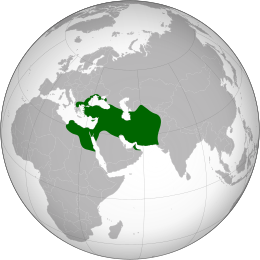Achaemenid Empire (550–330 BCE): Difference between revisions
More languages
More actions
(Created) Tag: Visual edit |
(Appointing outside rulers) Tag: Visual edit |
||
| (3 intermediate revisions by the same user not shown) | |||
| Line 1: | Line 1: | ||
{{Infobox country|name=Achaemenid Empire|image_flag=Standard of Cyrus the Great.svg|government_type=Monarchy|life_span=550 BCE–330 BCE|flag_type=Standard|image_map=Achaemenid map.svg|map_width=260|map_caption=The empire at its height around 500 BCE|common_languages=Old Persian<br>Aramaic|area_km2=5,500,000}} | {{Infobox country|name=Achaemenid Empire|image_flag=Standard of Cyrus the Great.svg|government_type=Monarchy|life_span=550 BCE–330 BCE|flag_type=Standard|image_map=Achaemenid map.svg|map_width=260|map_caption=The empire at its height around 500 BCE|common_languages=Old Persian<br>Aramaic|area_km2=5,500,000}} | ||
The '''Achaemenid Empire''', also known as the '''First Persian Empire''', was a multinational ancient state stretching from what is now [[Republic of Bulgaria|Bulgaria]] to [[Islamic Republic of Pakistan|Pakistan]]. It began in 550 BCE with the unification of Persia and Media and quickly grew to include [[Egypt]] and much of [[Western Asia]].<ref>{{Citation|author=Neil Faulkner|year=2013|title=A Marxist History of the World: From Neanderthals to Neoliberals|chapter=Ancient Empires|page=29|pdf=https://cloudflare-ipfs.com/ipfs/bafykbzacedljwr5izotdclz23o3c5p4di4t3ero3ncbfytip55slhiz4otuls?filename=Neil%20Faulkner%20-%20A%20Marxist%20History%20of%20the%20World_%20From%20Neanderthals%20to%20Neoliberals-Pluto%20Press%20%282013%29.pdf|publisher=Pluto Press|isbn=9781849648639|lg=https://libgen.rs/book/index.php?md5=91CA6C708BFE15444FE27899217FBA8E}}</ref> | The '''Achaemenid Empire''', also known as the '''First Persian Empire''', was a multinational ancient state stretching from what is now [[Republic of Bulgaria|Bulgaria]] to [[Islamic Republic of Pakistan|Pakistan]]. It began in 550 BCE with the unification of Persia and Media and quickly grew to include [[Egypt]] and much of [[Western Asia]]. The empire fell after [[Alexander the Great|Alexander]] of [[Macedon]] conquered Persepolis in 331 BCE.<ref name=":0">{{Citation|author=Neil Faulkner|year=2013|title=A Marxist History of the World: From Neanderthals to Neoliberals|chapter=Ancient Empires|page=29–42|pdf=https://cloudflare-ipfs.com/ipfs/bafykbzacedljwr5izotdclz23o3c5p4di4t3ero3ncbfytip55slhiz4otuls?filename=Neil%20Faulkner%20-%20A%20Marxist%20History%20of%20the%20World_%20From%20Neanderthals%20to%20Neoliberals-Pluto%20Press%20%282013%29.pdf|publisher=Pluto Press|isbn=9781849648639|lg=https://libgen.rs/book/index.php?md5=91CA6C708BFE15444FE27899217FBA8E}}</ref> | ||
== History == | |||
In 357 BCE, [[Cyrus the Great]] allowed a group of [[Judaism|Jewish]] exiles to travel to [[Palestine]] from Babylonia.<ref name=":02">{{Citation|author=Neil Faulkner|year=2013|title=A Marxist History of the World: From Neanderthals to Neoliberals|chapter=The End of Antiquity|page=54|pdf=https://cloudflare-ipfs.com/ipfs/bafykbzacedljwr5izotdclz23o3c5p4di4t3ero3ncbfytip55slhiz4otuls?filename=Neil%20Faulkner%20-%20A%20Marxist%20History%20of%20the%20World_%20From%20Neanderthals%20to%20Neoliberals-Pluto%20Press%20%282013%29.pdf|publisher=Pluto Press|isbn=9781849648639|lg=https://libgen.rs/book/index.php?md5=91CA6C708BFE15444FE27899217FBA8E}}</ref> Persia attempted to invade [[Ancient Greece|Greece]] twice but was defeated at Marathon in 490 BCE and Salamis in 480 BCE. Macedon destroyed the empire in 331 BCE at the Battle of Gaugamela.<ref name=":0" /> | |||
== Government == | |||
The empire was divided into tribute-paying provinces ruled by satraps, with roads and a postal system connecting different regions. Satraps controlled large armies, but the King would take control of the military in the event of a major rebellion or foreign expeditions. Local kings and satraps held immense power, causing frequent rebellions.<ref name=":0" /> | |||
Persia appointed foreign rulers to govern its cities because they would not take sides in family conflicts.<ref>{{Web citation|date=2023-05-05|title=Origins of debt: Michael Hudson reveals how financial oligarchies in Greece & Rome shaped our world|url=https://geopoliticaleconomy.com/2023/05/24/debt-michael-hudson-oligarchies-greece-rome/|newspaper=[[Geopolitical Economy Report]]|archive-url=https://web.archive.org/web/20230528041512/https://geopoliticaleconomy.com/2023/05/24/debt-michael-hudson-oligarchies-greece-rome/|archive-date=2023-05-28|author=[[Ben Norton]], [[Michael Hudson]]}}</ref> | |||
== Military == | |||
Each ethnic group in the Achaemenid military retained its own fighting style; for example, the Persians fought as spear infantry and the Medes were light cavalry.<ref name=":0" /> | |||
== References == | == References == | ||
[[Category:Ancient history]] | [[Category:Ancient history]] | ||
Latest revision as of 15:12, 28 May 2023
| Achaemenid Empire | |
|---|---|
| 550 BCE–330 BCE | |
|
Standard | |
 The empire at its height around 500 BCE | |
| Common languages | Old Persian Aramaic |
| Government | Monarchy |
| Area | |
• Total | 5,500,000 km² |
The Achaemenid Empire, also known as the First Persian Empire, was a multinational ancient state stretching from what is now Bulgaria to Pakistan. It began in 550 BCE with the unification of Persia and Media and quickly grew to include Egypt and much of Western Asia. The empire fell after Alexander of Macedon conquered Persepolis in 331 BCE.[1]
History[edit | edit source]
In 357 BCE, Cyrus the Great allowed a group of Jewish exiles to travel to Palestine from Babylonia.[2] Persia attempted to invade Greece twice but was defeated at Marathon in 490 BCE and Salamis in 480 BCE. Macedon destroyed the empire in 331 BCE at the Battle of Gaugamela.[1]
Government[edit | edit source]
The empire was divided into tribute-paying provinces ruled by satraps, with roads and a postal system connecting different regions. Satraps controlled large armies, but the King would take control of the military in the event of a major rebellion or foreign expeditions. Local kings and satraps held immense power, causing frequent rebellions.[1]
Persia appointed foreign rulers to govern its cities because they would not take sides in family conflicts.[3]
Military[edit | edit source]
Each ethnic group in the Achaemenid military retained its own fighting style; for example, the Persians fought as spear infantry and the Medes were light cavalry.[1]
References[edit | edit source]
- ↑ 1.0 1.1 1.2 1.3 Neil Faulkner (2013). A Marxist History of the World: From Neanderthals to Neoliberals: 'Ancient Empires' (pp. 29–42). [PDF] Pluto Press. ISBN 9781849648639 [LG]
- ↑ Neil Faulkner (2013). A Marxist History of the World: From Neanderthals to Neoliberals: 'The End of Antiquity' (p. 54). [PDF] Pluto Press. ISBN 9781849648639 [LG]
- ↑ Ben Norton, Michael Hudson (2023-05-05). "Origins of debt: Michael Hudson reveals how financial oligarchies in Greece & Rome shaped our world" Geopolitical Economy Report. Archived from the original on 2023-05-28.

